Freed of London began making ballet shoes in London in the 1930s and continue to produce bespoke shoes for the world’s most prestigious dancers. We went behind the scenes to find out about how they make their shoes.
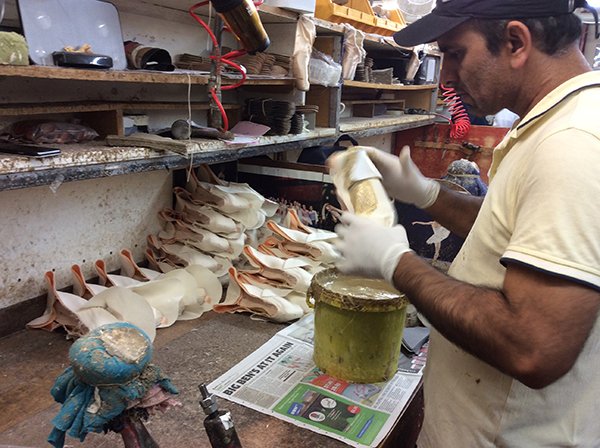
Freed of London is one of the world’s leading ballet and dance shoe manufacturers. From a factory in Hackney they hand-craft shoes for clients all over the globe. We took a trip to the factory to see where the magic takes place, and to find out more about this unique British shoemaker.
Can you tell me about the history of Freed?
Freed was established in 1929, by Mr and Mrs Freed. Frederick Freed was a cobbler, Mrs Freed was a milliner, and together they designed the way that we still make our ballet shoes today.
Freed started in a basement in Covent Garden, the same place that Freed still has a shop today. When Mr Freed first opened his shop he put a sign in the window saying that he would make a shoe to fit a ballerina, not the ballerina having to fit the shoe, because up until that time ballerinas always had awful feet as they used to put their feet into shoes that were ill-fitting.
This sign gained his first customer – Dame Margot Fonteyn. She came to him and said she would like to be fitted and became his first famous ballerina.
How has the manufacturing of the shoes changed since Mr Freed started the business?
They have evolved only slightly since, mainly as the technique in ballet has evolved. However, the raw components and the physical way that we make them is still the same.
Freed shoes are made of all natural fibres, so they’re a nice quiet pointe shoe. This means that when you’re on stage, you focus on the ballet, not on the shoe.
And he made all the shoes himself when he started out?
Yes!
What prompted the move to the factory in Hackney?
One of the turning points for the business was when Mr Freed went to show George Balanchine (co-founder of the New York City Ballet) his ballet shoes. Balanchine said that if he never changed the colour of his satin then New York City Ballet would always buy their pointe shoes from us.
The shoe is still the same shade of pink, and New York City Ballet still buy Freed ballet shoes to this day. It’s what we call a ballet pink which is a slight peachy pink colour. It’s a colour very specific to Freed ballet shoes.
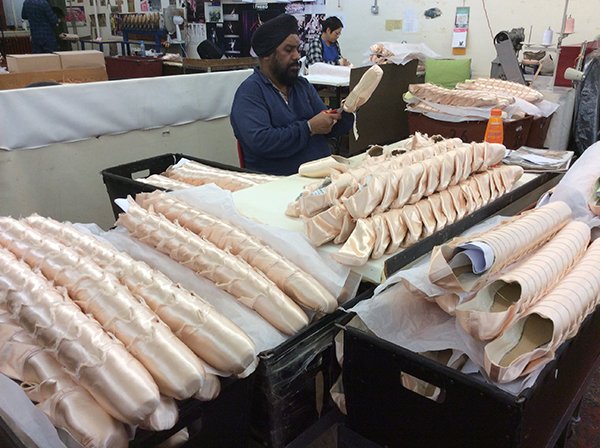
Are there any other specific features of your ballet shoes construction that make them unique to Freed?
The block, which is the hard part on the top of a pointe shoe, is made from something we call ‘paste’. We make our own paste in house and that has a secret ingredient, making them unique to us.
Our shoes are also biodegradable because they’re made from all natural fibres, and because of that they are very quiet on stage. Pointe shoes from other brands often have plastic in the block are quite noisy on stage in comparison.
How many makers do you have here in the Hackney factory?
As a company we employ over 200 people, but we have 27 makers at the moment – that’s what we call the employees who make the pointe shoes.
The construction of the shoe and the final fit varies from maker to maker. A slight maker will make a shoe that’s slightly more lightweight and more tapered. A maker who’s bigger-set will make a bigger, slightly heavier shoe. That allows us to bespoke make and fit ballerinas perfectly, and the ballet dancers know which maker has made her shoes by way of a stamp on the bottom. Each maker has their own symbol, which they’re given when they start with us and they’re assigned their ballerinas.
How long does it take to train someone up to be a ballet shoe maker and what qualities do you look for?
Some learn quicker than others, and to some making comes naturally. But on average we say it will take them a year to become a proficient maker. To find them, we put ads in the shop window. Sometimes we also advertise positions through Hackney or Leicester Council.
It’s a very physical job. You need the upper body strength to be able to make ballet shoes, due to the way the shoes are formed over the last. Our makers also need a lot of tenacity because they are working on their own making each shoe -they need to be independent and self-motivated to do the job.
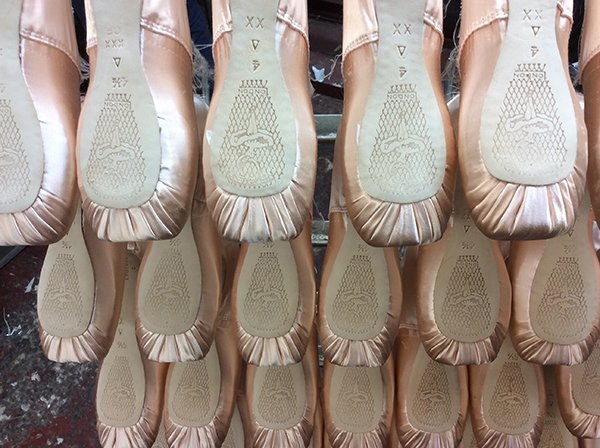
Do the ballerinas come to the factory for fittings?
Most of them go to the London shop, but we do have a team that travel worldwide to all of the ballet companies to fit them. They may go to the Paris Opera or to the New York City Ballet, and then the artistic director will arrange for all the dancers to come in at a certain time, so that they all have their own bespoke fitting.
You also make your ballroom dancing shoes at your factory in Hackney too, can you tell us about them?
We make all different levels of ballroom shoes – from professional ballroom shoes to latin and tap shoes, plus children’s shoes and teaching shoes. We also do a range for the more mature dancer which includes features like a wider fitting, and a comfort lining.
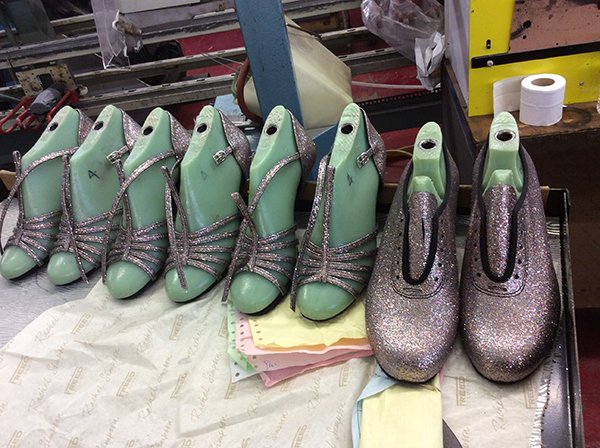
Do you have any other factories apart from the one in Hackney?
We have two more factories, one in Leicester and one in Norwich. The one in Leicester makes more pointe shoes and also garments, and the factory in Norwich makes soft ballet shoes, and tap shoes.
Do you make bespoke shoes for members of the public?
Yes we do. There’s one lady that lives local to our factory, and she has size 11 or 12 feet. Some years ago she bought a last and we make shoes for her every so often, because she can’t find shoes that fit her on the high street.
For bespoke made shoes they’re very reasonably priced. If you consider how much you’d pay for a bespoke suit made on Savile Row, these shoes are very affordable.
That’s right. You could purchase a bespoke shoe from Freed for around £100.
Has there ever been a time when the business has thought, it would be cheaper to make them overseas somewhere?
We have the conversation every week and we’d be silly if we didn’t. Every manufacturer has to look at what else is going on, but making in the UK is inbred in our company. If we ever took the manufacturing overseas we wouldn’t be Freed of London.
We couldn’t have the makers elsewhere, we couldn’t keep an eye on the quality and we couldn’t maintain all the bespoke shoes that we make. We don’t operate a production line, it’s a bespoke process.
There’s a big team at Freed – there’s an administration team; a fitting team; a marketing team; a making team; the binding room, we couldn’t manage that offshore. Also on the garment side of the business in Leicester, we have a wonderful team of sewing ladies that have been with us for years and years, and the quality and the love that they put into making the garments, we couldn’t get that elsewhere. We’re so lucky to have the people that work for us.
Do you think the fact the shoes are made in Britain matters to your customers?
I think it does more today. If you looked back ten years ago it wouldn’t have mattered, because it was about getting cheap imports, but I think there’s been a big change in people’s thought process about having quality products. Customers know that they can buy a cheaper shoe from abroad, but it doesn’t last as long and it won’t be bespoke. That’s the service we offer. In ballroom we have professional dancers, and they’ll want their shoes to be more flexible, or wider, or to match their dress or tail suit and we can bespoke make for them. There’s so much that we do here that we couldn’t do offshore.
How many pairs of shoes do you make in a year?
We make 250,000 pairs of ballet shoes a year across our three sites. The amount of ballroom dancing shoes is smaller but we’re currently on a big expansion with the ballroom shoes, which is really exciting. Ballroom has become very popular and people have become very much aware that dancing is a good form of keep fit for those that don’t want to go to a gym.
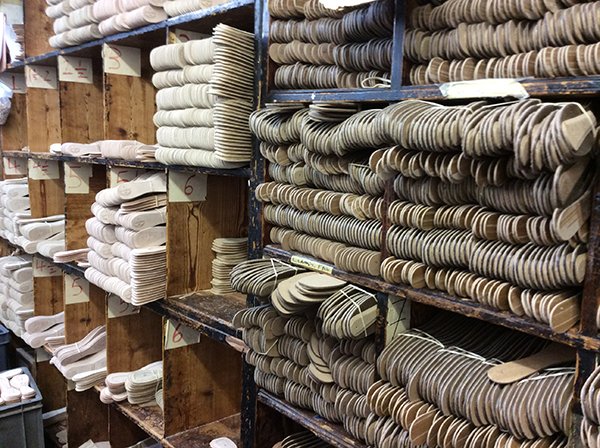
Can you tell me a little bit more about the design of the ballroom shoes?
We have one man called Jimmy who designs all of our ballroom shoes, and he’s in his late 60s! He loves his job and we’d love Jimmy to stay here forever really!
It’s quite a specialist job isn’t it designing ballroom shoes?
It’s the amount of detail that goes into the shoe. It’s not just a standard shoe, it has to work; it has to be flexible; it has to move in the right way; it has to arch with the foot; you have to allow for drags; it has to have a good point; it has to move with the foot; there’s so many different adaptations and he has to make it work in all these different ways.
Does Jimmy have real dancers come to test the shoe out?
We give him a brief, and he’ll come up with some styles, then the sales team and the manufacturing team will meet to choose from the designs. Those that are the strongest are sent out to dancers to test, to see if they make the grade. Sometimes they’ll be perfect, sometimes they need changing, we do a lot of adaptations on shoes before they actually get on the shelves.
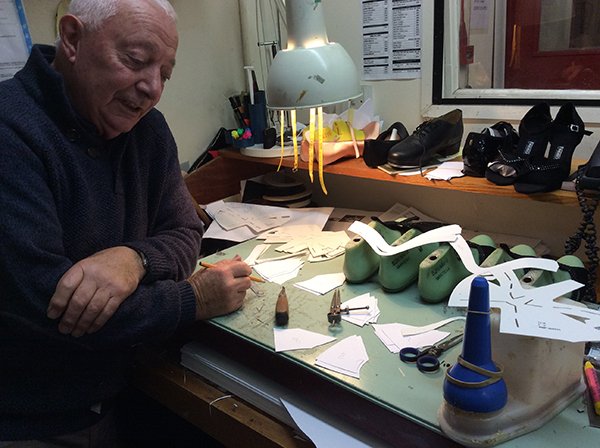
What are the biggest challenges Freed faces as a British manufacturer?
Brexit hasn’t helped because the raw materials costs have gone up, even if the goods are made here and supplied to us here. There’s always some little component that we can’t source here, for example the leather skins. Although we offer a wonderful service we still have to maintain a competitive pricing structure for our shoes and garments.
Finding new makers is also a challenge. That is finding people that want to create something and want to work in a factory. It seems everybody wants to be on the X Factor nowadays and people don’t always know the beauty of making. I don’t think it’s portrayed very well and I don’t think the government does enough to tell people that it is still a good living. There are a lot of qualities to working in a factory. We need to remind people that this a lovely factory and it’s a happy and exciting environment to work in.
Some of our makers have been working here for a very long time, we have one maker who is about to retire at Christmas, he’s been with us for over 40 years. People used to bring family members into the business, but that doesn’t happen so much now.
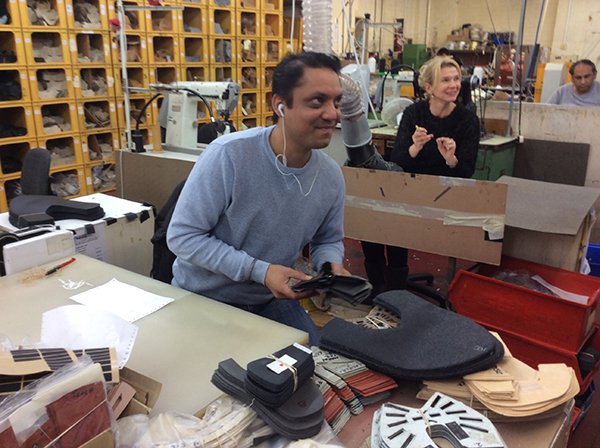
What are the plans for the future of Freed of London?
We’re looking to employ another four pointe shoe makers, to cover retirement and expansion. We are further expanding the ballroom side and have 25 new styles that we’re going to launch soon too.
You can find out more about Freed of London here.
